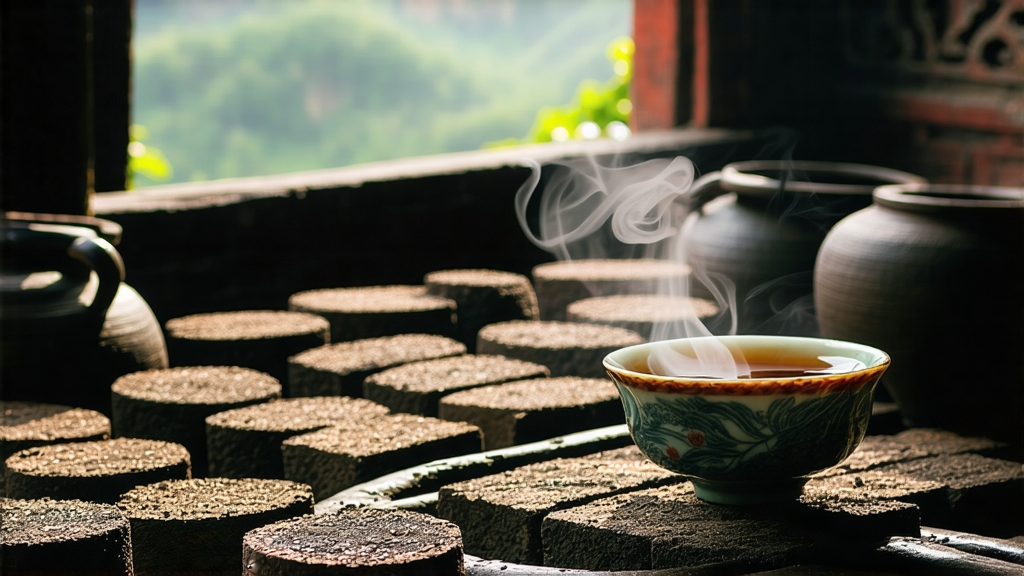
Tucked away in the humid, karst-pocked mountains of southern China’s Guangxi Zhuang Autonomous Region, Liu Bao tea has spent the last four centuries quietly fermenting its way into the hearts of dockworkers, emperors, and now, a new wave of global tea lovers. To the uninitiated, “dark tea” (heicha) can feel like an enigmatic corner of the Camellia sinensis universe—neither green freshness nor black briskness, but something that smells of earth after rain, of old books, of the forest floor. Liu Bao is the most maritime of these dark teas, a leaf that once sailed the Seventeenth-Century Tea-Horse Road, ballasted in the holds of bamboo-wrapped baskets, absorbing the salt and sway of the Pearl River Delta before reaching Southeast Asian ports where it became a breakfast staple in dim-sum halls and a medicinal tonic in Kuala Lumpur’s Chinese pharmacies.
History: From Imperial Tribute to Kopitiam Cup
The earliest written record appears in the 1620 edition of Cangwu County Gazetteer, noting that “dark tea from Liu Bao village relieves dampness and counters malarial airs.” By the Qing dynasty’s Qianlong era (1736–1795), the tea was listed among the imperial tributes shipped north via the Xunjiang River and Grand Canal. Jute-lined, double-layered bamboo baskets—called longzhu, or “dragon baskets”—became the standard export package, a design that allowed the tea to continue breathing during months on humid junks. When British and Dutch traders began transshipping it through Penang and Batavia, dockside Malays nicknamed it “teh tua lok,” old tea, valuing its ability to settle stomachs after a night of spiced laksa. Thus Liu Bao became one of the first Chinese teas to develop a devoted overseas following before ever reaching Western Europe.
Terroir and Leaf Style
Liu Bao is geographically protected; only leaf grown within the 8,000 km² micro-basin of the Liujiang, Xunjiang and Guijiang rivers may bear the name. The cultivar pool is intentionally diverse—old-seed Xiao Ye (small leaf), Zhong Ye (medium leaf) and the indigenous Guangxi Da Ye (broad leaf) are inter-planted on red lateritic soils at 200–800 m elevation. The monsoonal climate delivers 1,600 mm of rain during the April–September picking window, coaxing leaves into a high polyphenol profile that later feeds the microbial fermentation. Picking standard is one bud with three or four leaves, plump enough to survive the long road of wet piling yet still tender enough to yield a sweet, betel-nut finish.
Craft: The Art of “Wo Dui”
After a brief withering under mountain shade, the leaves are wok-fried at 280 °C for eight minutes to kill green enzymes, then rolled for 30 minutes on bamboo trays to rupture cell walls. What follows is the defining step: wo dui, wet piling. Unlike shou Pu-er’s mechanized piling, Liu Bao’s heap is modest—usually 500 kg, no higher than 70 cm—placed on the cool clay floor of a Qing-dynasty warehouse whose walls breathe with centuries of resident yeasts. Workers sprinkle river water drawn from the Liujiang at dawn, aiming for 28–30 % moisture, then cover the mound with thick hemp canvases. Over the next 25–35 days the pile is turned only five times, allowing internal temperatures to peak at 55 °C and fostering a microbial consortium dominated by Aspergillus niger, Blastobotrys adeninivorans, and a local hero, Candida tropicalis GXU01, recently sequenced by Nanning University. The slower rhythm yields a lighter, more aromatic fermentation than its Yunnan cousin—think damp forest, not barnyard. Once the pile exudes a sweet, jujube-like note, the tea is sun-dried on bamboo racks for three days, then moved to shaded loft chambers where it “rests” for at least three months before compression.
Basket Aging: Bamboo as Breathing Vessel
Traditional Liu Bao is not pressed into cakes but repacked into the same style of dragon baskets—35 kg for export, 500 g mini-baskets for modern boutique markets. The bamboo strips, still green when woven, contract as they dry, creating micro-gaps that allow oxygen to continue the slow